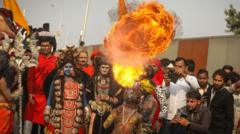In the northern Indian city of Prayagraj, the Mahakumbh Mela — known as the largest congregation of humanity on earth — has commenced, drawing millions of pilgrims from across the globe. This six-week-long festival, deeply rooted in Hindu tradition, sees devotees travel immense distances to immerse themselves in the sacred waters at Sangam, the point where the Ganges and Yamuna rivers meet, along with the mythical Saraswati. The act of bathing here is believed to cleanse sins and promote spiritual purification.
To accommodate this massive influx, authorities have constructed an expansive tent city, covering approximately 4,000 hectares along the riverbanks. The preparations for this tent city began as early as September of the previous year, with the area now bustling with activity as devotees arrive in vibrant processions filled with song and dance, enhancing the festival's celebratory atmosphere.
Approximately 400 million attendees are anticipated over the festival's 45-day span, creating a vibrant tapestry of rituals and cultural expressions. Among the various participants are ash-smeared pilgrims and holy men, including the striking Naga sadhus who embrace the chilling waters of the river, symbolizing the ultimate surrender to their faith.
While the festival's physical scale is vast, it also represents a profound moment of cultural identity for many Hindus. Those participating, especially the ascetics and spiritual leaders, view the Mahakumbh Mela as a pivotal opportunity for spiritual renewal and communal gathering.
Local residents and visitors witness the spectacle as a unifying experience, while onlookers from different backgrounds often interpret the festival through lenses of curiosity and cultural appreciation. As activities proceed at a thrilling pace, the festival is set to conclude on February 26, marking another chapter in India's rich spiritual heritage and captivating the world's attention.
To accommodate this massive influx, authorities have constructed an expansive tent city, covering approximately 4,000 hectares along the riverbanks. The preparations for this tent city began as early as September of the previous year, with the area now bustling with activity as devotees arrive in vibrant processions filled with song and dance, enhancing the festival's celebratory atmosphere.
Approximately 400 million attendees are anticipated over the festival's 45-day span, creating a vibrant tapestry of rituals and cultural expressions. Among the various participants are ash-smeared pilgrims and holy men, including the striking Naga sadhus who embrace the chilling waters of the river, symbolizing the ultimate surrender to their faith.
While the festival's physical scale is vast, it also represents a profound moment of cultural identity for many Hindus. Those participating, especially the ascetics and spiritual leaders, view the Mahakumbh Mela as a pivotal opportunity for spiritual renewal and communal gathering.
Local residents and visitors witness the spectacle as a unifying experience, while onlookers from different backgrounds often interpret the festival through lenses of curiosity and cultural appreciation. As activities proceed at a thrilling pace, the festival is set to conclude on February 26, marking another chapter in India's rich spiritual heritage and captivating the world's attention.




















